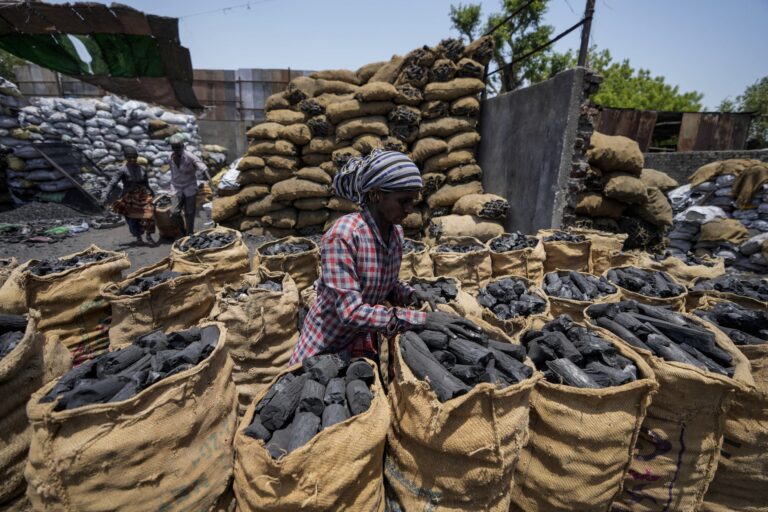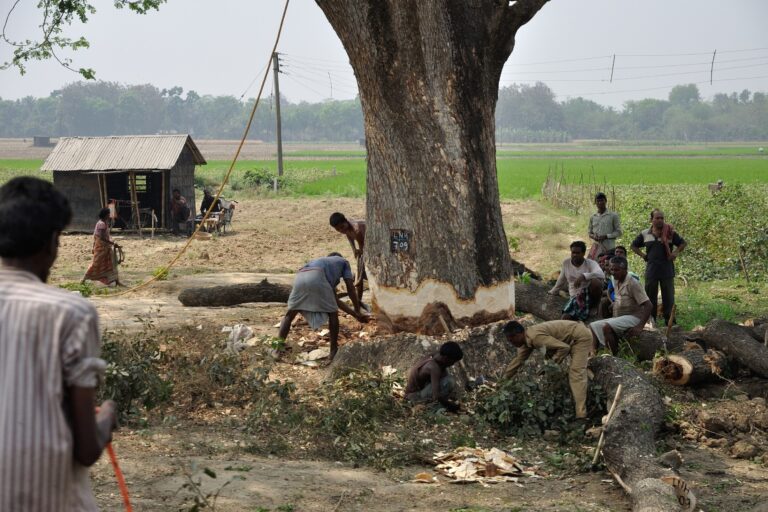- The number of mangroves in the Sundarbans, spanning India and Bangladesh, hasn’t reduced significantly in the last 30 years. However, there is evidence of a decline in the health of about 25 percent of the mangrove trees, a study has said.
- It is possible that the long-term decline is due to the effect of increased salinity on H. fomes, the dominant mangrove species in the Sundarbans which is a low-salinity tolerant species.
- Sundarbans forest is resilient to cyclone events but the long-term degrading effects of climate change could critically hamper its ability to spring back, the researchers said.
- The authors applied the Continuous Change Detection and Classification (CCDC) method to the Landsat data to find changes on the earth’s surface using satellite data to pinpoint when a specific area changes from being occupied by mangroves to being bare soil or water. The method, though computationally expensive, should be considered for global application to mangrove monitoring, they said.
While the Sundarbans forest in India and Bangladesh is resilient to cyclone events, the long-term degrading effects of climate change could critically hamper its ability to spring back, a satellite data-based study of the world’s contiguous mangrove system has said.
“What we are seeing in the study is that the number of mangroves (in the entire Sundarbans) hasn’t reduced significantly in the last 30 years. However, there is evidence of a decline in the health of about 25 percent of the mangrove trees,” said study author Katie Awty-Carroll of Department of Geography and Earth Sciences, Aberystwyth University, Wales.
And those areas will be more exposed to harm in the future, especially if extreme events such as cyclones become more common, Awty-Carroll said.
Awty-Carroll and colleagues tapped into a 30-year time series of Landsat data (January 1988 to June 2018) covering the entire Sundarbans. The Landsat program (by NASA and USGS) offers the longest continuous space-based record of the Earth’s surface.
The Sundarbans forest spans the delta formed by the confluence of the Ganges, Brahmaputra and Meghna river systems. The 10,000 square kilometre region stretches along the coast of Bangladesh (where 60 percent of the forest lies) and India.
Though it is difficult to know for sure what would cause the studied decline in mangrove health, the scientists speculate the long-term deterioration in mangrove health may be linked to the impacts of increased salinity on Heritiera fomes, or the sundari tree, the dominant mangrove species in the Sundarbans.
H. fomes is less tolerant of high salinity levels than other mangrove species and has previously been identified as suffering from die-back due to rising salinity. The species can grow up to 25 metres in height and is under the endangered category in the IUCN Red List. Die-back disease has been a large-scale problem since 1980 and was estimated to affect 5–6 percent of H. fomes in 2010.
It is possible that the long-term decline is due to the effect of increased salinity on H. fomes as a result of rising sea levels, said Awty-Carroll.
R. Santhosha, a forest department official who is in charge of one of the two administrative divisions that the Sundarbans in India are split into, attested to the long-term decline in sundari population.
“The principal cause for their decline is the rise in salinity. The diversity in mangrove species and the makeup of the mangroves determine their resilience,” Santhosha, Divisional Forest Officer (DFO) of South 24 Paraganas Forest Division, West Bengal, India, told Mongabay-India.

Waxing and waning
The scientists examined mangrove extent and greening and browning trends in the entire Sundarbans over thirty years using the Landsat data archive and Continuous Change Detection and Classification (CCDC) method. CCDC is used to find changes on the earth’s surface using satellite data to pinpoint when a specific area changes from being occupied by mangroves to being bare soil or water.
Greening indicates that the health of the mangrove forest is increasing. “Like with any plant life, if there are more leaves or the leaves themselves are getting greener, the plant is probably growing and is healthy,” the researcher explained.
Browning indicates that there is a decrease in the health of the trees – perhaps there are fewer healthy leaves per tree, or fewer trees in the same area. In terms of conservation, identifying specific areas of browning could help to better target conservation efforts, she said.
The analysis shows that around 75 percent of the Sundarbans has become greener over the last 30 years and no significant decrease in forest area was found over that time. “Other studies suggest that the number of Sundarbans mangroves has remained stable or decreased very slightly over the last few decades, and this is also what we found,” said Awty-Carroll.
She explained while some areas are being eroded, new land is being formed in other areas which mangroves have colonised. “However, if 25 percent of the forest is getting less healthy, those areas will be at greater risk of decline in the future, especially if extreme events such as cyclones become more common,” Awty-Carroll said.
For example, during the 1999 Odisha supercyclone, mangroves significantly reduced the number of human deaths in Kendarapara, one of the worst-hit coastal districts in Odisha. Villages with wider mangroves between them and the coast experienced significantly fewer deaths than the ones with narrower or no mangroves.
Hundreds of meters of mangroves are needed to significantly reduce waves.
Though some researchers are skeptical about the ability of mangroves to shield against tsunamis, there is growing evidence, particularly from the devastating Indian Ocean tsunami of 2004, that mangroves reduced tsunami impacts by reducing the destructive energy of water flowing inland.
Read more: On the frontline of disasters, mangroves at the receiving end of development and climate change
According to the study, if some of the browning trend is due to the effects of increased salinity due to rising sea levels, that problem will only get worse. Most of the observed browning is in Bangladesh, where the population of H. fomes trees is highest.
More than five million people depend on the Sundarbans mangroves for resources. While much of the Sundarbans has been designated a United Nations Educational, Scientific and Cultural Organisation (UNESCO) World Heritage Site, it remains threatened by human actions such as over-exploitation, illegal logging, pollution, and expanding industries such as shrimp farming.
In addition, rising sea levels are increasing salinity in the delta, with adverse effects on the Damage from severe cyclones, such as Aila and Sidr, in combination with rising sea levels, means that the protective capacity of the Sundarbans could be reduced in future years which is why adequate monitoring of mangrove abundance and health is vital.
Damage extent and recovery
As a case study on damage extent and recovery from a major cyclone, Sidr, a category 5 storm which made landfall in Bangladesh in November, 2007, was also investigated.
“We estimated that around 11 percent of the Sundarbans forest was damaged by Sidr, which is lower than other estimates. However, our study is the only one which looks at damage over the whole of the Sundarbans region immediately after the cyclone’s landfall,” said Awty-Carroll.
Looking at recovery over a longer period than what other research has considered, this study found evidence that the effects of Sidr were still apparent more than 10 years after the cyclone made landfall. This suggests that major cyclones like Sidr could reduce the long-term health and resilience of the mangroves. The researchers also said a similar analysis, using the CCDC method, could be applied to studying the impact of other cyclones.

Additionally, the technique could also help accurately evaluate the baseline extents of important habitats particularly if the full data archive is exploited.
For example, the study points out that the total area of mangroves in the Sundarbans in the present day is estimated around 6600 square km, as against the total area of the Sundarbans which is often cited as around 10,000 square km.
Recent studies using Landsat data place the estimate of actual mangrove forest closer to 6000–7000 square km. “Our estimate is, therefore, in line with previous studies,” said Awty-Carroll.
The proposed methodology, while computationally expensive, also offers means by which the full Landsat archive can be analysed and interpreted and should be considered for global application to mangrove monitoring, the authors write in the study.
The method is computationally expensive because it involves dividing a potentially very large area (in this case the whole Sundarbans region) into 30m x 30m sections and running an analysis on each one separately over the full 30 years of data. Performing this kind of analysis has only really become accessible in the last few years due to the amount of computing power needed, the researcher said.
“If you think of a satellite image, every pixel in that image represents an area on the ground. In the case of the NASA Landsat satellites, which we used for this study, each pixel represents a 30m x 30m patch of ground,” adds Awty-Carroll.
These satellites (there have been seven of them so far) have been collecting data continuously roughly every 8-16 days for more than 30 years. “So what we can do is take each 30m x 30m area, and track it through time using the satellite data. CCDC takes that data and tries to capture the underlying signal – for example, vegetation will have a seasonal pattern where it is greener at some times of year than at others.”
The main limitation of the study is the absence of on-the-ground measurements to compare the satellite observations. “The Sundarbans forest covers a large and diverse area which makes data collection on the ground very difficult. Without this data, we can’t be absolutely sure of what is causing the changes we can see in the satellite data, and for that reason, we have to be cautious in interpreting our results,” Awty-Carroll added.
Andy Large, a field-based physical geographer with Newcastle University, who was not associated with the study said the work is timely as significant mangrove degradation would imply that the protective capacity of the Sundarbans could be reduced in future years – just as this protective capacity is needed due to rising sea levels from climate change.
“Up to now, evidence for the decline on mangrove has been based on small scale surveys and much of the Sundarbans remains off-limits due to its protected heritage status,” Large told Mongabay-India.
Gaps in our understanding persist, added Large. “Mangrove dynamics in the Sundarbans region are complex, particularly when examined over a long time period. On-the-ground verification (or ‘ground-truthing’) of the story painted by the remote sensing analysis remains a research gap,” he said echoing Awty-Carroll’s concerns.
The indications are that saline intrusion, a feature seen across South and South-East Asian deltas are now significantly threatening the Sundarbans canopy cover, said Large, adding that research needs to continue into coastal resilience and tipping points and feed as early as possible into the regional policy for the protection of these beautiful and valuable coastal ecosystems.
As the director of the GCRF Living Deltas Hub, an interdisciplinary research hub on the Red River, Mekong and the Ganges-Brahmaputra-Meghna, Large stressed on equitable partnerships with delta-dwellers and the research community working together to co-develop solutions including in on-the-ground measurements and monitoring of parameters such as salinity. Citizen science and climate communication through education would be key to the hub’s work in the Sundarbans mangroves.

CITATION:
Awty-Carroll, K., Bunting, P., Hardy, A., & Bell, G. (2019). Using Continuous Change Detection and Classification of Landsat Data to Investigate Long-Term Mangrove Dynamics in the Sundarbans Region. Remote Sensing, 11(23), 2833.
Banner image: A spotted deer in the Indian Sundarbans. Photo by Kartik Chandramouli/Mongabay.













